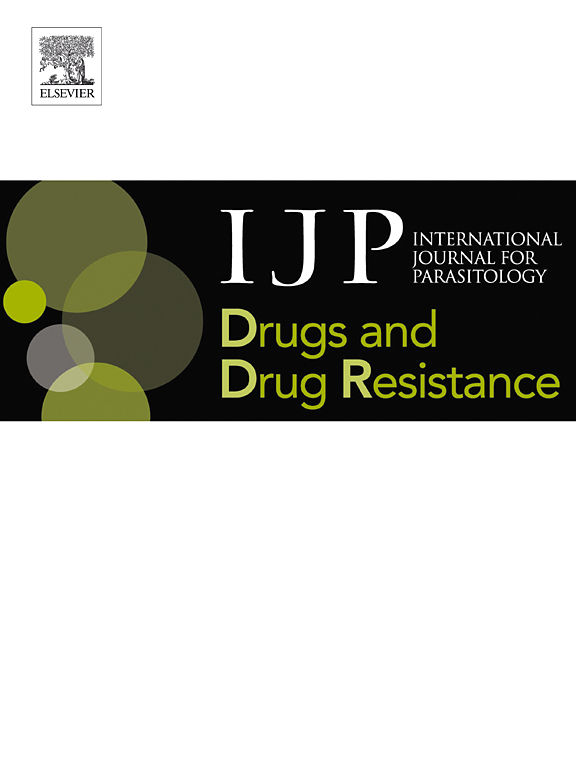Comparative proteomic analysis of metronidazole-sensitive and resistant Trichomonas vaginalis suggests a novel mode of metronidazole action and resistance
IF 3.4
2区 医学
Q1 PARASITOLOGY
International Journal for Parasitology: Drugs and Drug Resistance
Pub Date : 2024-09-26
DOI:10.1016/j.ijpddr.2024.100566
引用次数: 0
Abstract
The microaerophilic parasite Trichomonas vaginalis occurs worldwide and causes inflammation of the urogenital tract, especially in women. With 156 million infections annually, trichomoniasis is the most prevalent non-viral sexually transmitted disease. Trichomoniasis is treated with 5-nitroimidazoles, especially metronidazole, which are prodrugs that have to be reduced at their nitro group to be activated. Resistance rates to metronidazole have remained comparably low, but they can be higher in certain areas leading to an increase of refractory cases. Metronidazole resistance in T. vaginalis can develop in vivo in clinical isolates, or it can be induced in the laboratory. Both types of resistance share certain characteristics but differ with regard to the dependence of ambient oxygen to become manifest. Although several candidate factors for metronidazole resistance have been described in the past, e.g. pyruvate:ferredoxin oxidoreductase and ferredoxin or thioredoxin reductase, open questions regarding their role in resistance have remained.
In order to address these questions, we performed a proteomic study with metronidazole-sensitive and –resistant laboratory strains, as well as with clinical strains, in order to identify factors causative for resistance. The list of proteins consistently associated with resistance was surprisingly short. Resistant laboratory and clinical strains only shared the downregulation of flavin reductase 1 (FR1), an enzyme previously identified to be involved in resistance. Originally, FR1 was believed to be an oxygen scavenging enzyme, but here we identified it as a ferric iron reductase which produces ferrous iron. Based on this finding and on further experimental evidence as presented herein, we propose a novel mechanism of metronidazole activation which is based on ferrous iron binding to proteins, thereby rendering them susceptible to complex formation with metronidazole. Upon resolution of iron-protein-metronidazole complexes, metronidazole radicals are formed which quickly react with thiols or proteins in the direct vicinity, leading to breaks in the peptide backbone.

对甲硝唑敏感和耐药阴道毛滴虫的蛋白质组比较分析表明了甲硝唑作用和耐药的新模式。
阴道毛滴虫(Trichomonas vaginalis)是一种嗜水性微寄生虫,分布于世界各地,会导致泌尿生殖道发炎,尤其是女性。滴虫病每年感染 1.56 亿人次,是最流行的非病毒性传播疾病。治疗滴虫病的药物是 5-硝基咪唑类,尤其是甲硝唑。对甲硝唑的耐药率相对较低,但在某些地区可能较高,导致难治性病例增加。阴道球菌对甲硝唑的耐药性可以在临床分离株体内产生,也可以在实验室中诱导产生。这两种抗药性都有某些共同的特征,但在对环境氧气的依赖性方面有所不同。尽管过去曾描述过甲硝唑耐药性的几种候选因子,如丙酮酸:铁氧还蛋白氧化还原酶和铁氧还蛋白或硫氧还蛋白还原酶,但关于它们在耐药性中的作用,仍有一些未决问题。为了解决这些问题,我们对甲硝唑敏感和耐药的实验室菌株以及临床菌株进行了蛋白质组学研究,以确定导致耐药性的因素。令人惊讶的是,与耐药性一致相关的蛋白质清单非常短。耐药的实验室菌株和临床菌株只有黄素还原酶 1(FR1)的下调是相同的,这种酶以前被认为与耐药性有关。最初,FR1 被认为是一种氧清除酶,但在这里我们发现它是一种产生亚铁的铁还原酶。基于这一发现和本文提出的进一步实验证据,我们提出了一种新的甲硝唑激活机制,该机制基于亚铁与蛋白质的结合,从而使蛋白质容易与甲硝唑形成复合物。铁-蛋白质-甲硝唑复合物分解后,会形成甲硝唑自由基,这些自由基会迅速与直接邻近的硫醇或蛋白质发生反应,导致肽骨断裂。
本文章由计算机程序翻译,如有差异,请以英文原文为准。
求助全文
约1分钟内获得全文
求助全文
来源期刊

International Journal for Parasitology: Drugs and Drug Resistance
PARASITOLOGY-PHARMACOLOGY & PHARMACY
CiteScore
7.90
自引率
7.50%
发文量
31
审稿时长
48 days
期刊介绍:
The International Journal for Parasitology – Drugs and Drug Resistance is one of a series of specialist, open access journals launched by the International Journal for Parasitology. It publishes the results of original research in the area of anti-parasite drug identification, development and evaluation, and parasite drug resistance. The journal also covers research into natural products as anti-parasitic agents, and bioactive parasite products. Studies can be aimed at unicellular or multicellular parasites of human or veterinary importance.
 求助内容:
求助内容: 应助结果提醒方式:
应助结果提醒方式:


